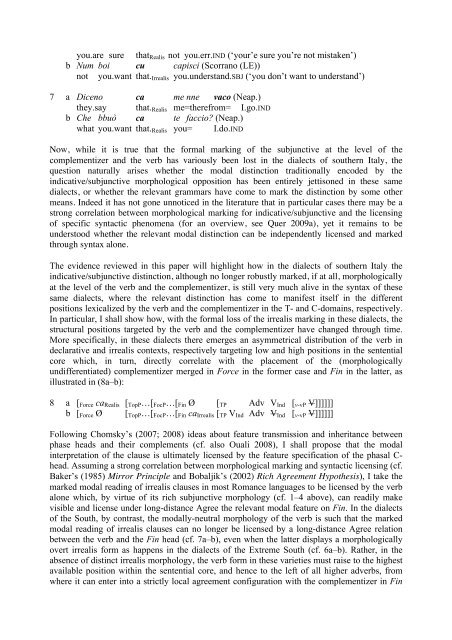The Fall and Rise of the Romance Subjunctive: A Syntactic ... - DiGS14
The Fall and Rise of the Romance Subjunctive: A Syntactic ... - DiGS14
The Fall and Rise of the Romance Subjunctive: A Syntactic ... - DiGS14
Create successful ePaper yourself
Turn your PDF publications into a flip-book with our unique Google optimized e-Paper software.
you.are sure thatRealis not you.err.IND (‘your’e sure you’re not mistaken’)<br />
b Num boi cu capisci (Scorrano (LE))<br />
not you.want that.Irrealis you.underst<strong>and</strong>.SBJ (‘you don’t want to underst<strong>and</strong>’)<br />
7 a Diceno ca me nne vaco (Neap.)<br />
<strong>the</strong>y.say that.Realis me=<strong>the</strong>refrom= I.go.IND<br />
b Che bbuò ca te faccio? (Neap.)<br />
what you.want that.Realis you= I.do.IND<br />
Now, while it is true that <strong>the</strong> formal marking <strong>of</strong> <strong>the</strong> subjunctive at <strong>the</strong> level <strong>of</strong> <strong>the</strong><br />
complementizer <strong>and</strong> <strong>the</strong> verb has variously been lost in <strong>the</strong> dialects <strong>of</strong> sou<strong>the</strong>rn Italy, <strong>the</strong><br />
question naturally arises whe<strong>the</strong>r <strong>the</strong> modal distinction traditionally encoded by <strong>the</strong><br />
indicative/subjunctive morphological opposition has been entirely jettisoned in <strong>the</strong>se same<br />
dialects, or whe<strong>the</strong>r <strong>the</strong> relevant grammars have come to mark <strong>the</strong> distinction by some o<strong>the</strong>r<br />
means. Indeed it has not gone unnoticed in <strong>the</strong> literature that in particular cases <strong>the</strong>re may be a<br />
strong correlation between morphological marking for indicative/subjunctive <strong>and</strong> <strong>the</strong> licensing<br />
<strong>of</strong> specific syntactic phenomena (for an overview, see Quer 2009a), yet it remains to be<br />
understood whe<strong>the</strong>r <strong>the</strong> relevant modal distinction can be independently licensed <strong>and</strong> marked<br />
through syntax alone.<br />
<strong>The</strong> evidence reviewed in this paper will highlight how in <strong>the</strong> dialects <strong>of</strong> sou<strong>the</strong>rn Italy <strong>the</strong><br />
indicative/subjunctive distinction, although no longer robustly marked, if at all, morphologically<br />
at <strong>the</strong> level <strong>of</strong> <strong>the</strong> verb <strong>and</strong> <strong>the</strong> complementizer, is still very much alive in <strong>the</strong> syntax <strong>of</strong> <strong>the</strong>se<br />
same dialects, where <strong>the</strong> relevant distinction has come to manifest itself in <strong>the</strong> different<br />
positions lexicalized by <strong>the</strong> verb <strong>and</strong> <strong>the</strong> complementizer in <strong>the</strong> T- <strong>and</strong> C-domains, respectively.<br />
In particular, I shall show how, with <strong>the</strong> formal loss <strong>of</strong> <strong>the</strong> irrealis marking in <strong>the</strong>se dialects, <strong>the</strong><br />
structural positions targeted by <strong>the</strong> verb <strong>and</strong> <strong>the</strong> complementizer have changed through time.<br />
More specifically, in <strong>the</strong>se dialects <strong>the</strong>re emerges an asymmetrical distribution <strong>of</strong> <strong>the</strong> verb in<br />
declarative <strong>and</strong> irrealis contexts, respectively targeting low <strong>and</strong> high positions in <strong>the</strong> sentential<br />
core which, in turn, directly correlate with <strong>the</strong> placement <strong>of</strong> <strong>the</strong> (morphologically<br />
undifferentiated) complementizer merged in Force in <strong>the</strong> former case <strong>and</strong> Fin in <strong>the</strong> latter, as<br />
illustrated in (8a–b):<br />
8 a [Force caRealis [TopP…[FocP…[Fin Ø [TP Adv VInd [v-vP V]]]]]]<br />
b [Force Ø [TopP…[FocP…[Fin caIrrealis [TP VInd Adv VInd [v-vP V]]]]]]<br />
Following Chomsky’s (2007; 2008) ideas about feature transmission <strong>and</strong> inheritance between<br />
phase heads <strong>and</strong> <strong>the</strong>ir complements (cf. also Ouali 2008), I shall propose that <strong>the</strong> modal<br />
interpretation <strong>of</strong> <strong>the</strong> clause is ultimately licensed by <strong>the</strong> feature specification <strong>of</strong> <strong>the</strong> phasal Chead.<br />
Assuming a strong correlation between morphological marking <strong>and</strong> syntactic licensing (cf.<br />
Baker’s (1985) Mirror Principle <strong>and</strong> Bobaljik’s (2002) Rich Agreement Hypo<strong>the</strong>sis), I take <strong>the</strong><br />
marked modal reading <strong>of</strong> irrealis clauses in most <strong>Romance</strong> languages to be licensed by <strong>the</strong> verb<br />
alone which, by virtue <strong>of</strong> its rich subjunctive morphology (cf. 1–4 above), can readily make<br />
visible <strong>and</strong> license under long-distance Agree <strong>the</strong> relevant modal feature on Fin. In <strong>the</strong> dialects<br />
<strong>of</strong> <strong>the</strong> South, by contrast, <strong>the</strong> modally-neutral morphology <strong>of</strong> <strong>the</strong> verb is such that <strong>the</strong> marked<br />
modal reading <strong>of</strong> irrealis clauses can no longer be licensed by a long-distance Agree relation<br />
between <strong>the</strong> verb <strong>and</strong> <strong>the</strong> Fin head (cf. 7a–b), even when <strong>the</strong> latter displays a morphologically<br />
overt irrealis form as happens in <strong>the</strong> dialects <strong>of</strong> <strong>the</strong> Extreme South (cf. 6a–b). Ra<strong>the</strong>r, in <strong>the</strong><br />
absence <strong>of</strong> distinct irrealis morphology, <strong>the</strong> verb form in <strong>the</strong>se varieties must raise to <strong>the</strong> highest<br />
available position within <strong>the</strong> sentential core, <strong>and</strong> hence to <strong>the</strong> left <strong>of</strong> all higher adverbs, from<br />
where it can enter into a strictly local agreement configuration with <strong>the</strong> complementizer in Fin


